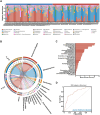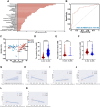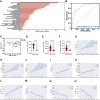Characteristics of stachyose-induced effects on gut microbiota and microbial metabolites in vitro associated with obesity in children
- PMID: 39171106
- PMCID: PMC11337871
- DOI: 10.3389/fnut.2024.1411374
Characteristics of stachyose-induced effects on gut microbiota and microbial metabolites in vitro associated with obesity in children
Abstract
Childhood obesity presents a serious health concern associated with gut microbiota alterations. Dietary interventions targeting the gut microbiota have emerged as promising strategies for managing obesity in children. This study aimed to elucidate the impact of stachyose (STS) supplementation on the gut microbiota composition and metabolic processes in obese children. Fecal samples were collected from 40 obese children (20 boys and 20 girls) aged between 6 and 15 and in vitro fermentation was conducted with or without the addition of STS, respectively, followed by 16S rRNA amplicon sequencing and analysis of short-chain fatty acids (SCFAs) and gases. Notably, our results revealed that STS supplementation led to significant alterations in gut microbiota composition, including an increase in the abundance of beneficial bacteria such as Bifidobacterium and Faecalibacterium, and a decrease in harmful bacteria including Escherichia-Shigella, Parabacteroides, Eggerthella, and Flavonifractor. Moreover, STS supplementation resulted in changes in SCFAs production, with significant increases in acetate levels and reductions in propionate and propionate, while simultaneously reducing the generation of gases such as H2S, H2, and NH3. The Area Under the Curve (AUC)-Random Forest algorithm and PICRUSt 2 were employed to identify valuable biomarkers and predict associations between the gut microbiota, metabolites, and metabolic pathways. The results not only contribute to the elucidation of STS's modulatory effects on gut microbiota but also underscore its potential in shaping metabolic activities within the gastrointestinal environment. Furthermore, our study underscores the significance of personalized nutrition interventions, particularly utilizing STS supplementation, in the management of childhood obesity through targeted modulation of gut microbial ecology and metabolic function.
Keywords: children; gut microbiota; microbial metabolites; obesity; prebiotics; stachyose.
Copyright © 2024 Pi, Du, Teng, Fu, Hu, Li, Ding, Yang and Zhang.
Conflict of interest statement
The authors declare that the research was conducted in the absence of any commercial or financial relationships that could be construed as a potential conflict of interest.
Figures






Similar articles
-
Effects of prebiotics on the gut microbiota in vitro associated with functional diarrhea in children.Front Microbiol. 2023 Sep 1;14:1233840. doi: 10.3389/fmicb.2023.1233840. eCollection 2023. Front Microbiol. 2023. PMID: 37720150 Free PMC article.
-
Characteristics of Gut Microbiome and Its Metabolites, Short-Chain Fatty Acids, in Children With Idiopathic Short Stature.Front Endocrinol (Lausanne). 2022 Jun 10;13:890200. doi: 10.3389/fendo.2022.890200. eCollection 2022. Front Endocrinol (Lausanne). 2022. PMID: 35757432 Free PMC article.
-
Short-chain fatty acids: microbial metabolites that alleviate stress-induced brain-gut axis alterations.J Physiol. 2018 Oct;596(20):4923-4944. doi: 10.1113/JP276431. Epub 2018 Aug 28. J Physiol. 2018. PMID: 30066368 Free PMC article.
-
Prebiotic effects: metabolic and health benefits.Br J Nutr. 2010 Aug;104 Suppl 2:S1-63. doi: 10.1017/S0007114510003363. Br J Nutr. 2010. PMID: 20920376 Review.
-
Potential interest of gut microbial changes induced by non-digestible carbohydrates of wheat in the management of obesity and related disorders.Curr Opin Clin Nutr Metab Care. 2010 Nov;13(6):722-8. doi: 10.1097/MCO.0b013e32833ec3fb. Curr Opin Clin Nutr Metab Care. 2010. PMID: 20823777 Review.
Cited by
-
The Role of Wolfiporia cocos (F. A. Wolf) Ryvarden and Gilb. Polysaccharides in Regulating the Gut Microbiota and Its Health Benefits.Molecules. 2025 Mar 7;30(6):1193. doi: 10.3390/molecules30061193. Molecules. 2025. PMID: 40141970 Free PMC article. Review.
-
Stachyose alleviates high-fat diet-induced obesity via browning of white adipose tissue and modulation of gut microbiota.Curr Res Food Sci. 2025 May 14;10:101081. doi: 10.1016/j.crfs.2025.101081. eCollection 2025. Curr Res Food Sci. 2025. PMID: 40485899 Free PMC article.
References
LinkOut - more resources
Full Text Sources

